
archives for 09/2008
This past spring, Mark decided he wanted to try a cash crop, something which required minimal care and could grow in crappy soil. Last year, we'd grown sweet potatoes in the good soil of our upper garden --- we planted them, ignored them, then harvested the beautiful tubers you see below. We were overwhelmed by the bounty and gave away perhaps a third of the harvest, then ended up not having quite enough to last us through the year.
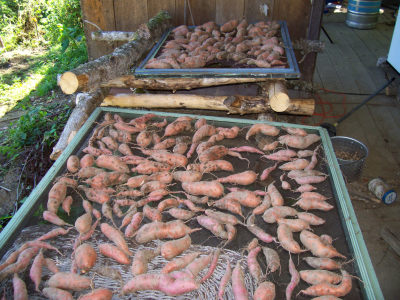
Given last year's success, sweet potatoes were an obvious choice for a cash crop this year. Mark bought $50 worth of starts and planted them in the much worse soil of the mule garden. We had so many slips that we even planted a dozen in a pure clay raised bed outside our kitchen window --- an effort which I figured was doomed to failure even though we'd been assured by our gardening friends that bad soil wouldn't be a problem.
Mark watched with pleasure as the sweet potatoes twined out across the clayey mule garden soil, unfurling their heart-shaped leaves to soak up the sunlight. The sweet potatoes outside the kitchen window grew much more slowly, struggling to stay afloat in the pure clay, but they still managed to cover their bed and dip down over the sides.
Then came the deer. First they just nibbled on a few plants at the end of the mule garden row, then they defoliated every sweet potato we'd planted (except for the ones by the kitchen window.) I rushed in with row covers and was able to cover up perhaps a fourth of the sweet potatoes, but the damage had already been done --- Mark's heart was broken.
For the rest of the summer, the deer nibbled on new sweet potato leaves after every rain and Mark avoided the mule garden. Finally, with the deer encroaching more and more every day, I decided it was time to get the sweet potatoes out of the ground before the deer did it for me.
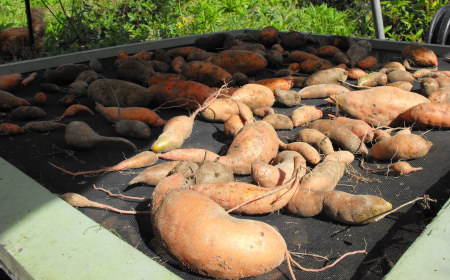
The plants which had been covered by the row cover made a respectable showing, but the uncovered plants barely produced enough to make it worth my while to pull them out. All told, the mule garden rows --- which covered an area approximately five times the size of last year's sweet potato beds --- produced just about the same amount of of sweet potatoes we'd gotten last year. Mark's dreams of a cash crop were sunk.
I did make him smile, though, when I finally went to dig out the pure clay bed by the kitchen window. I'd made such a point of telling him --- repeatedly --- that there was no way we'd get any sweet potatoes out of that bed. But when I slipped my fingers into the cracked clay, I pulled out the biggest tubers we'd grown this year or last, and the most of them! At least we now know that the sweet potatoes really do thrive on neglect...as long as we can get the deer to neglect them too.
|
Tips:
|
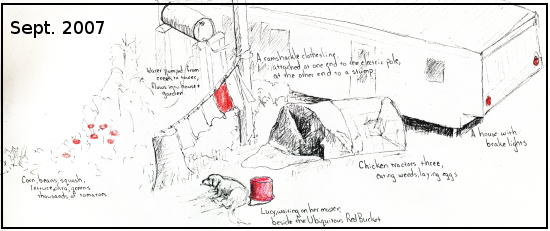
- Water pumped from creek to tower, flows into house and garden.
- Corn, beans, squash, lettuce, okra, greens, and thousands of tomatoes.
- A ramshackle clothesline, attached at one end to the electric pole, at the other end to a stump.
- Chicken tractors three, eating weeds, laying eggs.
- Lucy, waiting on her master, beside the Ubiquitous Red Bucket.
- A house with brake lights."
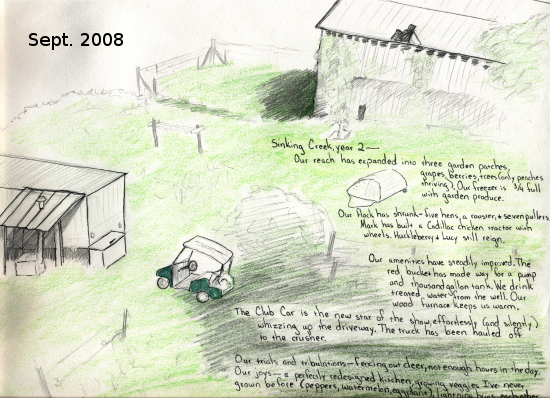
- Our reach has expanded into three garden patches, grapes, berries, trees (only peaches thriving.) Our freezer is 3/4 full with garden produce.
- Our flock has shrunk --- five hens, a rooster, and seven pullets. Mark has built a Cadillac chicken tractor with wheels. Huckleberry and Lucy still reign.
- Our amenities have steadily improved. The red bucket has made way for a pump and thousand gallon tank. We drink treated water from the well. Our wood furnace keeps us warm.
- The Club Car is the new star of the show, effortlessly (and silently) whizzing up the driveway. The truck has been hauled off to the crusher.
- Our trials and tribulations --- fencing out deer, not enough hours in the day.
- Our joys --- a perfectly redesigned kitchen, growing veggies I've never grown before (peppers, watermelon, eggplant), lightning bugs, each other..."
A retrospective from November 2006
|
Summing it up:
|
I
am the daughter of two back-to-the-landers who retreated to the city
when their kids were in elementary school. Up until the age of
eight, I played in creeks, climbed trees and hills, and peered at
wild animals --- and didn't do a lick of the farm work. By the time
my father became worn out from working a full time job then coming
home to fields of tobacco, beef cows, and a vegetable garden, I had
idealized life on the farm and couldn't imagine living anywhere else. I
threatened to run away rather than move to town. In the end I
didn't run away, but as soon as I was able I ran back.
As
the crow flies, the land I purchased sixteen years later is only
about twenty miles from the farm where I grew up. Winding on
highways and back roads through mountain passes and over rivers, the
drive takes an hour and a half. I brought my childhood memories
along for the ride and fell in love with the 58 acre property the
first time I saw it. The property's crowning jewel is Sinking Creek
which runs near the eastern border through land which my biology
training calls a floodplain but which my childhood on a farm calls
the perfect place to wade and look at minnows on a hot summer day.
The
property had been a farm a few decades ago, until the last
inhabitants tired of crossing Sinking Creek and wading through a
third of a mile of mud to reach the one area both flat and dry enough
to support a barn and house. Neighbors tell me that the land had
been on the market for years, every prospective buyer scared away by
the same creek which immediately enchanted me.
Or
perhaps prospective buyers were understandably worried by the
tendency of Sinking Creek to rise from low on a pair of rubber boots
to up above my waist in less than an hour during particularly heavy
storms. Sinking Creek drops out of sight into an underground cave
system a short way downstream from my property, and when the small
opening becomes clogged with floating debris, the creek backs up. To
do Sinking Creek justice, it soon reverts to its mild-mannered ways
and can be crossed without getting my feet wet after only a day or
two of dry weather. Since I work over the internet, I have the
flexibility to use floods as an excuse to stay home and enjoy the wet
world.
The
chink in my plans arose when I began to consider the realities of
life at Sinking Creek. With no way to drive into the interior of the
property, I would be unable to get electricity and telephone hookups
(both essential for my internet work). Although the barn was in
excellent shape, the house was falling down and building materials
would need to be brought in to shore it up or to build a new living
space. So I began to consider bridging the creek.
My
upstream neighbors had installed three huge metal culverts to span
Sinking Creek, but rushing water soon washed the culverts out. The
creek is too wide to be spanned by one length of used railroad ties,
and attempting to install a pier in the middle of the creek seemed to
be asking for trouble.
I
was obviously out of my league, so I asked a professional builder to
come out and give me an estimate on building a bridge. He
recommended buying used steel beams from the department of
transportation, but said that just the beams themselves would run me
upwards of $4,000. The driveway leading up to the creek is too
narrow for a concrete truck to get through, which would create even
more problems. As much as I pushed, the builder seemed reluctant to
even wager a guess at the final price of bridging Sinking Creek.
I
gulped. Although the land had come cheap, the purchase had wiped out
my scanty savings and I was not inclined to go further into debt to
build a bridge. My goal was to live simply on the land, producing
most of my food and supplementing my income with internet work. Debt
would force me into a full-time job, and, eventually, off the land I
had dreamed of for so many years.
At
about this time, I acquired a very handy boyfriend (Mark) who shared
my dream of living on the land. Between us we cooked up a way to
cross the creek at minimal expense and with a structure which
wouldn't be washed away in the first big flood. Our plan was to
create a shallow water crossing lined with cinderblocks --- a ford to
drive across with four wheel drive vehicles. Luckily, my property is
only a ten minute drive from a quarry and a cinderblock plant, so I
would be able to get rock and cinderblocks relatively cheaply.
As
the first step in our venture, we hauled in several loads of
cinderblocks, choosing six inch blocks for their cheapness and ease
of handling. The blocks cost $500 --- the most expensive part of the
project --- and we later discovered that “seconds” (slightly
chipped blocks) were available for about two-thirds of the price.
The
next step was to get our family and friends excited about coming to
play in
the dirt. We invited as many people as we could think of to come to
a work day that weekend, and four hard workers showed up. We also
rented a bobcat to help us move dirt around --- an expense of $150
which could have been avoided if we'd wanted to do all of the digging
by hand. We rented the bobcat on a Saturday morning, which gave us
two days for the price of one since the office was closed on Sunday
and the machine wasn't due back until Monday morning.
Early
on a chilly November morning, Mark fired up the bobcat and began to
grade the bank of the creek. Sinking Creek's banks were originally
vertical walls of clay about three feet tall, and our goal was to
turn them into shallow ramps which any vehicle could navigate as it
drove into or out of the creek. Southwest Virginia's creeks are home
to many rare mussel species which can be harmed by muddy water, so we
worked to push the dirt up onto the banks rather than down into the
creek itself.
After
getting the bobcat stuck in the creek once, we decided that it was
best to do any digging in the water by hand. Luckily for our backs,
all we had to do in the creek was to remove a thin layer of creek
gravel so that the blocks would lie just above the level of the creek
bottom. I knew that the weight of driving across the blocks was
likely to cause them to sink slightly into the ground. After
sinking, I wanted the blocks to lie at about ground level so that
they would not impede the flow of the creek and get washed away.
Initially,
Mark and I had planned to lay the cinderblocks on their sides so that
the water could run through the holes. However, we soon discovered
that the strength of cinderblocks lies in their proper orientation,
with the holes pointing from the ground up to the sky. Whenever
possible, we gained additional strength by staggered the rows of
blocks just like a bricklayer would do.
My
work party enjoyed digging out the mud and laying the blocks. Everyone
from my sixty-two year old mother to Mark's teenage nephew
had work which was within their physical capability. In fact, they
had so much fun that they continued to beg for more work parties for
weeks into the future.
At
the end of the work weekend, half of the ford was completed. We had
dug out the bed, laid the blocks, and filled the blocks' holes back
in with bank dirt and creek gravel. Mark and I ended up digging out
the far bank by hand in the next week after returning the bobcat. We
laid block for about ten feet on each approach to the creek, since
these areas had been dug out and were likely to be slippery when wet.
Sinking
Creek's floods weighed heavily on both Mark's and my minds, so we
decided to add a little further insurance against our ford washing
away. We drove five metal fence posts into the holes in five
cinderblocks on the downstream end of the ford, then mixed some bags
of concrete in a wheelbarrow to pour into the holes and hold the
fence posts in place. We also poured a bit of concrete into the
blocks at the edge of the ford where a slight bend in the creek
forces quickly moving water against the bank.
Finally,
we went to the quarry and got some gravel to add to the road leading
up to the ford. We also bought rip-rap --- stones about two to six
inches in diameter --- for the price of roughly $5 per small pickup
truck load. One load of rip-rap was enough to pile against the
downstream end of the ford. This rip-rap prevents erosion of the
creek bottom due to the slight waterfall effect as water flows over
the ford and then falls three inches or so to the ground.
All
told, construction of our ford cost less than $800 and about a week's
worth of our time. Since the initial blocks were laid, we have made
a few minor adjustments to our design. We dug out some more of the
far bank to decrease the slope since our pickup truck's bumper
scraped slightly while going up and down. We also added a bit of
width to the ford to make it easier to navigate.
A
year later, our ford has survived numerous floods without a single
cinderblock coming out of place. Mark and I now live in a fifty foot
trailer which we dragged across the ford using a bulldozer --- all
without harming the ford in any way. The electric company was able
to cross our ford and hook us up so that I can write this while
peering out at the fifty-eight acres of trees which I have yearned to
live in for so long.
Nowadays,
Mark and I consider Sinking Creek to be our moat, a method of keeping
out unwanted visitors. On hot summer days, I paddle in the water,
and our Chesapeake Bay retriever fetches sticks in Sinking Creek's
deep pools even in the dead of winter. The mussel, fish, and snail
populations in the creek seem to be as healthy as ever, as is my
wallet. Although the reality of life on a small farm involves more
work than I recall from my childhood, I am thankful every day that
Mark and I call this bit of land home, and that we decided not to
fight the creek with a bridge and instead went with the flow.
Last year we planted a
few pounds each of Yukon Gold, Kennebec, and red potatoes and
discovered the Kennebecs were by far our favorite. So this year
we bought a 50 pound bag of Kennebecs and planted them in every spare
corner of the garden.
Unfortunately, the feed
store did us wrong --- the "Kennebecs" weren't actually
Kennebecs. They acted, tasted, and looked more like Yukon Golds,
which we really don't like much. So now it's time to harvest our
potatoes and we just don't like them!
What should we do?
|
|
 Last
Tuesday and Wednesday night, the outside temperature dropped down
to 38 F --- not quite a frost but close enough to nip the sensitive
basil leaves. When I went out the next morning, I could see brown
bruises forming on the leaves and knew that if I wanted to make another
basil harvest I'd better act fast.
Last
Tuesday and Wednesday night, the outside temperature dropped down
to 38 F --- not quite a frost but close enough to nip the sensitive
basil leaves. When I went out the next morning, I could see brown
bruises forming on the leaves and knew that if I wanted to make another
basil harvest I'd better act fast.
Mark and I grow one bed
of basil (about four feet by three feet), which gives us enough of the
spicy herb for the whole year. We adore pesto, which I use as our
"I'm starving and need dinner in fifteen minutes with no work!" meal
year-round by freezing it like crazy all summer. Luckily, basil
is the easiest crop in our entire garden --- I plant it thick so that
after weeding it once it outcompetes the weeds and needs no more care
for the rest of the year. Until frost threatens, that is...
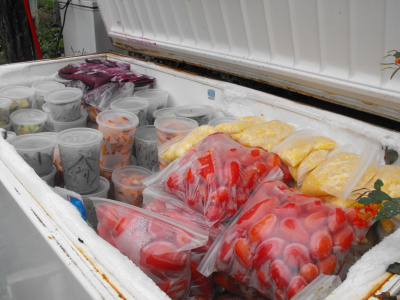
So I got to work this
morning snipping off the tops of the basil plants with my garden
scissors then whirring them in the blender with walnuts, olive oil,
garlic, parmesan, salt, and pepper, before scooping them into
individual ziplock bags. I've read that other people like to
freeze them in ice cube trays, but to me that's a lot of work....
Instead, I freeze about a cup at a time --- enough to make a big batch
of pesto to feed me and Mark for two meals.
An hour later, I had eleven baggies of pesto ready to pop in the
freezer. There are few things more heartening as the first frost
approaches than a nearly full freezer!
This year, I worked to solve at least the first problem. I took a Master Gardener class a few years ago and ended up with a wonderful 600 page reference guide which I am constantly flipping through as I search for information. I've reproduced one page of it below. (This version is actually from a factsheet called "Fall Vegetable Gardening" which you can download for free from the extension service website.)
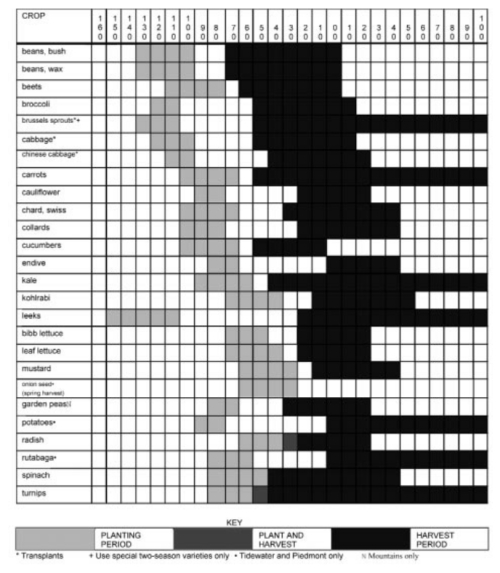
As you can see, now that we feel the first signs of fall, it's too late to plant anything except mustard. However, don't lose heart if you haven't planted a fall garden --- there's always cold frames! (More on those later --- lettuce in cold frames is one of my favorites!)
 My first suggestion for someone like yourself is the old
phrase
realtors throw around. Location. Location. Location. When I'm unsure of
what part of the planet I should be near I cover my walls with maps of
potential spots.
My first suggestion for someone like yourself is the old
phrase
realtors throw around. Location. Location. Location. When I'm unsure of
what part of the planet I should be near I cover my walls with maps of
potential spots. 
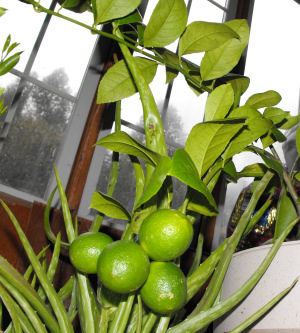 When I recorded the daily maximum and minimum
temperatures before going to bed last night, I was shocked to notice
that it had gotten down to 33 F outdoors the night before. So I
scurried around in the dark to bring in my most sensitive plants, just
in case it got one degree colder that night.
When I recorded the daily maximum and minimum
temperatures before going to bed last night, I was shocked to notice
that it had gotten down to 33 F outdoors the night before. So I
scurried around in the dark to bring in my most sensitive plants, just
in case it got one degree colder that night.